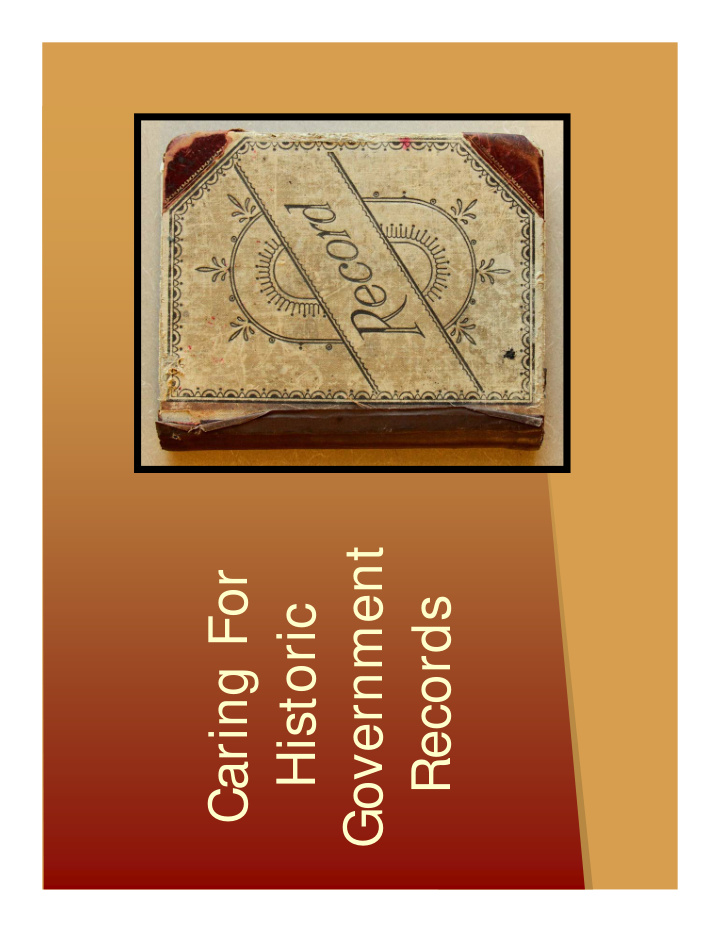



Government Caring For Historic Records
Agenda Part 1: Role of the Archivist Part 2: What Records Need to be Preserved Part 3: Organizing Historic Records Part 4: Preserving Your Records Part 5: Providing Access to Historic Records Summary
The Role of the Archivist Part 1
What Does an Archivist Do? Preserves and Provides Access to Historic Records Appraisal Arrangement and Description Preservation Care Reference
What Records Need to Be Preserved ? PART 2
The Life-span of Records Temporary Records Permanent Records Records Retention
Records Appraisal Appraisal is analyzing the fiscal, administrative, legal, historic, and intrinsic value of a group of records and their relationship with other records.
Records Appraisal Value Fiscal Administrative Legal Historical Intrinsic
Records Appraisal Examples: Department Annual Reports City Council Minutes Building Permits Parking Tickets Animal Licenses
Two Fundamental Questions Do the records have permanent value? Do the records still have administrative value in the office? Ownership of government records State Archives is the end-of-the-line repository
Records Appraisal Proper records appraisal tells you which records need to be preserved permanently
Retention Schedules General Retention Schedules http://archives.utah.gov/recordsmanagement Unique Retention Schedules – Consult with the State Archives
General Retention Schedules
Comments and Questions?
Historic Records Organizing Part 3
Organizing Records Physical Control Intellectual Control
Arrangement Fundamental Concepts: Provenance Original Order Ease of Access
Arrangement Examples: Cemetery Burial Permits Police mug shots Parks Department photos Planning Commission minutes
Intellectual Control Know what records you have Conduct periodic inventories Create inventory lists
Inventory List Title of records Dates Arrangement Basic description Inventory list
Inventory List Table of contents of the records Box 1 Minutes January, 1955- Folder 1 June, 1955 Minutes July, 1955 - Folder 2 November, 1955 Minutes December, Folder 3 1955 - May, 1956
Comments and Questions?
Part 4 Preservation of Historic Records Threats to Records: Water Heat Light Dirt and Pollutants Rodents and pests Handling Fire Theft or Loss
Preservation of Historic Records Physical Housing Storage Facilities Reformatting
Preservation of Historic Records Physical Housing – Archival Supplies: Acid free file folders Acid free paper for interleafing Archival storage boxes Mylar enclosures
Loose Paper
Loose Paper
Bound Volumes
Bound Volumes
Maps, Drawings and Oversize Materials
Maps, Drawings and Oversize Materials
Maps, Drawings and Oversize Materials
Photographic Media Photographs contain chemicals on their surface and are extremely delicate. They can also be irreversibly changed through poor handling, so extreme caution must be taken to preserve these materials. Handle photographs while wearing clean cotton or polyester gloves. Consider storing negatives in Mylar negative sheets.
Photographic Media
Scrapbooks
Reformatting Microfilm – Microfilm is an eye-readable format – Master copy is off-site back-up copy – Reproducible – Requires little storage space. Digital copies – Primarily for access Reformat and Retire
Records Storage Space Make an assessment of your building
Preservation of Historic Records Threats to Records: Water Heat Light Dirt and Pollutants Rodents and pests Handling Fire Theft or Loss
Preservation of Historic Records Storage Facility Dry Climate controlled Dark (protected from UV light) Clean Locked and secure
Preservation of Historic Records Storage Facility Avoid storing historic records in the basement or the attic If you must… – Store in archival quality boxes – 4-6 inches off the floor – Monitor for pests and rodents – Routinely check for water problems – Fire extinguishers and smoke detectors
Environment Control Controlling the environmental conditions so that deterioration is prevented
Climate Control: Minimum Requirements Stable conditions Limit fluctuations Temperature: no higher than 70 degrees F RH: 30% - 50% – No lower than 30% Monitoring Equipment
Record Storage Equipment Shelving Cabinets Oversize cabinets
Physical Security Well constructed doors Deadbolt locks for all storage areas Secure windows Alarms Key tracking Box labels
Preserving Your Records Create a basic disaster plan Have disaster response supplies on hand
Preserving Your Records Do not do anything to your records that cannot be undone.
Comments and Questions?
Access to Providing Historic Records Part 5
Access to Historic Records Four Considerations: Public Right to Access Protection of Restricted Information Appropriate Space Protecting the Records
Access to Historic Records Government Records Access and Management Act (GRAMA): Public right to view and take a copy Protection of private, controlled, and protected information
Access Space Work surfaces with adequate lighting Space for users to store their belongings Copy machine
Protecting Records Maintain a sign-in log for records users Don’t allow food, pens, or other items that could damage records Don’t allow unsupervised access Don’t check out records Use reformatted copies for access to fragile materials
Take Home Concepts
What Records Should Be Preserved? Understand appraisal principles Rely on established retention schedules when available Consult the State Archives for unusual cases
Organizing Records Physical Control: Provenance Original Order Ease of Access Intellectual Control: Create a records inventory
Storing Records Water, light, heat, pests, theft, etc. can threaten records Threats can be minimized with proper storage containers and proper storage space A disaster preparedness plan can help minimize damage
Public Access Right to access must be balanced with legal restrictions Access should be provided while still protecting records from damage or theft
Contacts and Links Utah State Archives: www.archives.utah.gov State Archives Research Center: www.historyresearch.utah.gov National Archives: www.archives.gov Northeast Document Conservation Center: www.nedcc.org California Preservation Program: www.calpreservation.org Conference of Intermountain Archivists: http://www.lib.utah.edu/cima/ Gaylord Supplies: www.gaylord.com Metal Edge Supplies: www.metaledgeinc.com
Utah State Archives Alan Barnett abarnett@utah.gov
Recommend
More recommend